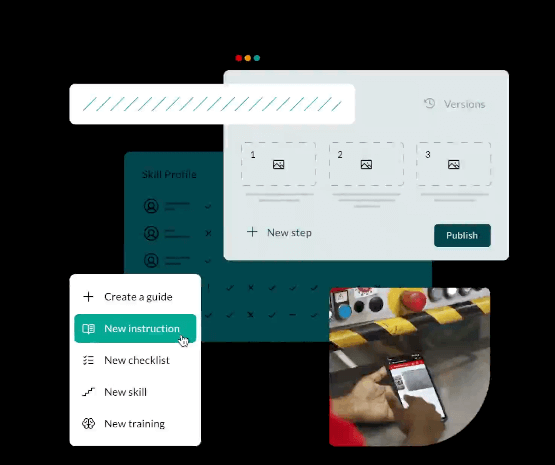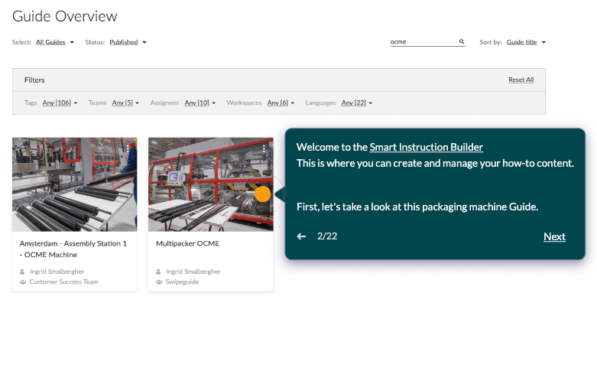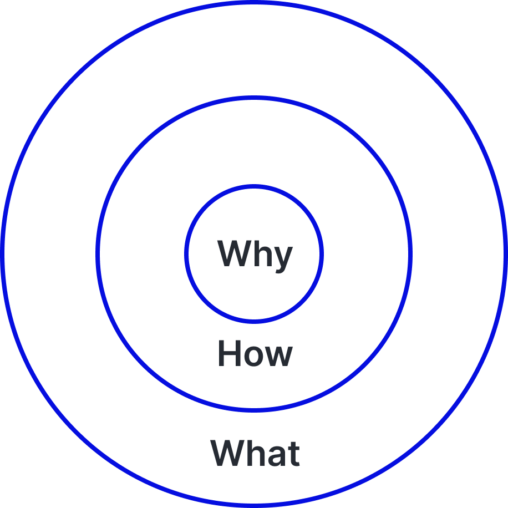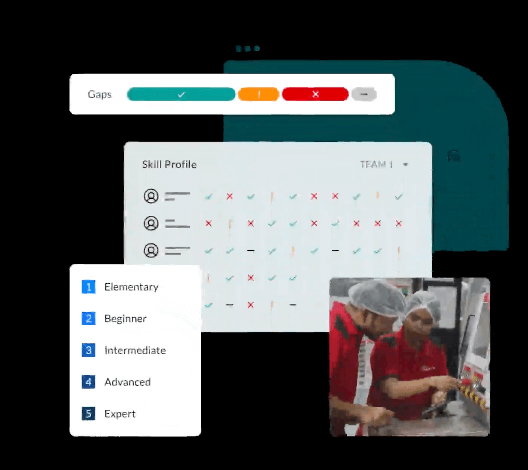16 July 2024
Let your employees grow on their own terms – SwipeGuide’s Sue Li on crowdsourced continuous improvement & innovation
Every company wants to improve continuously, but does every employee of every company want the same? SwipeGuide’s CTO, Sue Li, believes that to succeed with CI efforts in the long term, you have to get the buy-in of your team members. Sue tells us how to do just that and where to go from there.
The CTO vs Status Quo series studies how CTOs challenge the current state of affairs at their company to push it toward a new height … or to save it from doom.
Crowdsourced CI is about involving your team
“Leadership and learning are indispensable to each other,” – once said John F. Kennedy. Today’s guest, Sue Li, believes that leaders can turn learning into a team effort to benefit the whole organization.
Sue Li is the CTO of SwipeGuide, which helps companies in the manufacturing industry improve their processes by empowering frontline workers. This crowdsourced continuous improvement is the essence of the SwipeGuide platform’s value proposition.
As she told us all about it, she discussed the CI practices in her own software team. It turns out that manufacturing and software have a lot in common in that regard, including:
- The principles – the main concepts behind crowdsourced CI, such as “starting with the Why,” empowerment, and alignment.
- The roles – less emphasis on top-down management in favor of new roles that aim to enable and support team activities.
- The tools – they help automate, create transparency, and ensure consistency.
Read up and see for yourself!

Bio
Sue has an extensive experience in education, which intersected with technology right from the start. In 2014, she became an instructional designer tasked with improving the digital learning experience for UX and web development courses. Simultaneously, she honed her tech skills, including full-stack knowledge of the JavaScript ecosystem. In 2020, she took on the position of CTO at SwipeGuide to do what she likes best – leveraging technology to improve the learning experience, this time in the manufacturing industry.
Expertise
Product development, full-stack development, Agile methodologies, UX, interaction design, learning technologies
Hobbies
Writing, traveling, design
SwipeGuide
The company was founded in 2015 in Amsterdam, the Netherlands, aiming to simplify work and help employees learn how to do any task more easily. SwipeGuide’s platform empowers people to collect and document knowledge on the job. The knowledge is then processed into easy-to-use and highly contextual guides, instructions, or SOPs that can be used on demand. SwipeGuide’s platform supports continuous improvement and sustainable production patterns when used consistently.
Interview with SwipeGuide’s Sue Li
Sławomir Turkiewicz: Hi Sue. Thanks for taking the time to participate in CTO vs Status Quo. The CTOs I talk to tend to be busy, and I’m sure it’s no different for you.
I read up on SwipeGuide’s latest initiatives, including the Smart Skills product. Tell me more about it. What’s its place within the broader SwipeGuide platform for frontline training?
We originally focused on instructional aids, or job aids, which are instructions organized into guides. To create these guides, we developed an easy-to-use content creation and management system. The content can then be published to different audiences depending on people’s roles, the factories, teams, or operating lines they’re part of.
Since enabling every worker to do their job well is part of our DNA, it made sense to continue with skills management and training, which can integrate these guides as learning materials. Last year, we launched the first version of Smart Skills, which is already being used by some of our biggest customers.
Smart Skills flips the traditional learning process in a company on its head. Typically, the manager gives the employee their score or written assessment. Instead, we wanted to give the employee the ability to self-evaluate first.
Employees now have an app that lists learning activities related to the skills they have or want to improve, depending on their roles and professional goals. They can mark activities as completed and track their progress. At any moment, the operators can request their managers to review their self-assessments and give feedback. Our skills matrix allows the manager or trainer to see an overview of their team, their skills, and who is qualified for what.
For the manager, the value we want to provide is the ability to identify skill gaps. Imagine you have a packaging line. If someone is out sick or on holiday, who else on your team is qualified for that skill? Who can step in for the shift? We want to provide that information.
It seems that Smart Skills places a lot of emphasis on employee education, especially self-learning, as a means of supporting continuous improvement. Is that correct?
As a former teacher and instructional designer, I’ve always been interested in new and innovative ways of learning. The traditional classroom model was the same for everyone, but now we know that learners are diverse. With technology, we can personalize the process and design different learning journeys. We can provide better insights to learners based on data and make it more student-centered.
With Smart Skills, everyone has the instructions to complete a task made available to them on the go and in the context of their job. It’s nothing like the traditional learning model. You aren’t in a classroom. You don’t sit around listening to someone speak, and then you go home to apply what you learned. You have a data-driven tool that actively puts the right knowledge in front of you when needed. This knowledge comes from the experience of frontline workers.
What more is SwipeGuide up to these days? Many companies today experiment with machine learning or AI. It seems like a no-brainer direction for a company that pursues efficiency, doesn’t it?
Our vision is to be able to automatically transform unstructured content into structured content, making it as easy to learn as possible.
We have designed our SwipeGuide format to be step-by-step. But when we onboard some customers, we often get huge Excel files, PDFs, and PowerPoints. We need to transform these files into an easy format for frontline workers. Our instructional designers do a great job supporting our customers, but it does take time. In the long term, we want something more efficient.
In the past year, we’ve experimented with existing tools to provide content recommendations. We worked on a feature that automatically parses a video into text and splits it into steps. In the future, we also want to experiment with generating skill frameworks. For example, imagine taking a skill like operating a bottling line and automatically breaking it down into all the skills you need to speed up the process of setting up your own skills framework from scratch.
The AI market is progressing fast, with giants like OpenAI, Microsoft, Google, and AWS in an arms race to develop the best LLM models. Over time, I think the ecosystem will become more democratized as companies start to produce more open-source tools to make AI development friendlier for developers – like AI as a service, which allows developers to leverage models for specific use cases, finetuning them for a specific context.
We’re not Google, Microsoft, or Open AI at the moment. We are a small but mighty product team trying to navigate our way forward, learning how to leverage the best tools to create a better user experience for our customers.

Why is continuous improvement hard?
Your platform is about helping companies improve, so continuous improvement is a friendly territory for you. However, the same isn’t true for many organizations.
At first glance, incremental improvement seems like such a simple concept, but many IT companies struggle to sustain positive change over time. Why do you think it is?
It’s very difficult to sustain an initiative for an entire organization on your own. That’s why it’s beneficial to involve your employees in setting up the CI process from the ground up.
One of the best strategies for continuous improvement is gathering knowledge from people directly involved in everyday processes.
For me, as a CTO, that’s my software development team. In manufacturing, that source of knowledge is the frontline employees. Whether in a software company or a factory, putting your teams at the forefront of knowledge generation naturally creates alignment in your organization because you start the change from the bottom up rather than the top down. That’s crowdsourcing knowledge for continuous improvement.
So it’s all about getting the manager to include everyone in laying the foundation for the CI strategy?
It is about changing the culture of the work environment.
Any type of change is hard. People can resist new ways of working, and adapting to new practices takes a lot of effort. But if you get people bought into why things need to change, you will have a much easier time. The goal is to create a culture where people are open and motivated to share their ideas and be part of that change.

Crowdsourced continuous improvement – processes
Let’s talk about crowdsourcing CI in practice. How do you start with this bottom-up approach and create alignment?
Several types of alignment are relevant when it comes to crowdsourced CI.
First, there’s organizational alignment – how aligned your teams are with each other and the rest of the organization. You need to ensure that all teams, while having their own operational objectives, cooperate with each other to achieve the same overall goals. To do that, once you set such business goals, you need to foster collaboration across teams.
There are many examples of how cross-collaboration helps achieve these overall goals. The product team needs to collaborate with other teams in areas such as customer success, sales, marketing, or compliance, and they all need to share the same business goals. If a customer success team talks about SLAs that guarantee 99.9% uptime, the infrastructure must support that.
Similarly, salespeople will want to inform customers who have compliance requirements about our security standards, like the SOC and ISO certifications. They need up-to-date information from the Security and Legal teams. And if a customer is going to launch SwipeGuide soon, my team also needs to ensure they have everything they need to succeed.
And then you’ve got the idea of alignment between the company’s goals and each and every employee’s internal motivation. Your team needs to believe that what you want to achieve makes sense to them personally. There’s a nice alignment model from Simon Sinek that I like using for that: start with ‘Why.’ You will get resistance if you start with ‘What’ or ‘How.’ That’s why you should start a change with ‘Why,’ then move to ‘How,’ which defines processes or definitions of success, and then end with ‘What.’
By the time you get to the ‘What’ part, the whole process becomes much easier because everyone is already aligned.
That’s the theory, at least. But how can the process be applied in practice? You can use storytelling supported by quantitative data. That can include use cases or testimonials from real users.
People aren’t always inspired by data, but they often get inspired by the stories, pain points, and experiences of other people. Tapping into this human element helps align people around the same goal.

How can companies overcome challenges in fostering cross-collaboration?
What really matters is having shared goals on a higher organizational level. To do this, you need to make goals transparent and be able to communicate them to different departments in a meaningful way. Today, especially in remote teams, important content gets lost constantly. People just go into their little wormhole on Slack. That’s why it’s important to simply have a call with someone. Or better yet, meet your colleagues in person from time to time.
Encouraging communication between all employees is also important for a company’s culture. You don’t want to end up with people who believe they all work on different problems. In the end, it’s one company.
We talked earlier about change being hard. You need to continue iterating your processes over time, and you need consistency in working with your teams to overcome any friction along the way.
Continuous improvement – the manager’s role
So, what is the role of a CTO or any other manager in crowdsourced continuous improvement?
My role as the CTO is to ensure the alignment of the technology organization with the business goals. To do that, I need to help my team understand business problems and goals, whether they are developers, designers, product managers, or anyone else on the team.
I feel successful when the team has a deep understanding of the business and can drive change themselves. They should have a safe space to make suggestions and proposals and see the impact they can make.
In order to do that, I need to ensure that people are supported – that the processes allow them to drive things forward and that they are enabled with the right tools, resources, and culture.
For example, we’ve modified how we hold meetings to address the team’s needs. We’ve updated the format of the meetings to be camera-optional or non-optional, depending on the type of participation that’s needed. We’ve also adjusted the meeting times when we realized our meetings were too long.
Let’s take stand-ups in particular. We’ve changed everything about the schedule – from stand-ups in the afternoon to stand-ups in the morning.
We’ve also discovered that sometimes we need to make the purpose of a meeting clearer. For example, we’ve added a rotating Scrum master who owns the effectiveness of a stand-up. We’ve tried different formats, focusing on everything from blockers to the flow of work. Sometimes, we have eliminated whole meetings or processes that no longer add value for the teams.
That’s what crowdsourced bottom-up continuous improvement is about – it’s driven by the teams.
What more can you do on a more operational level?
I can ensure that we have the right goals and metrics in place. They also help people go in the right direction.
For example, we have developed engineering pillars centered around concepts that we believe are necessary for excellent engineering, including quality, maintainability, continuous integration, and delivery.
Overall, we’ve picked five pillars and defined specific metrics to track progress toward our goals. In the beginning, I measured and reported on them, but eventually, the team came to own these processes. Over time, certain processes or artifacts gain everyone’s buy-in and become ingrained in our way of working.
Continuous improvement – tools
We talked about general processes. Let’s now focus on how to carry and use knowledge most efficiently. Tell me more about your favorite CI toolset.
Once you have clear goals in place, the key is to make it as easy as possible to visualize, measure, and work toward them with the right tools.
It is very important to visualize the flow of work using a Kanban board (you can use any type of tool or technology for this, whether it’s Jira, Trello, Notion, Teams, etc.) This helps identify bottlenecks in progress and which parts of the process are slowing the team down.
In addition, we try to automate the processes to standardize them and make them more effective. For quality code reviews, we use an automatic code analysis tool. It helps you measure technical debt and the maintainability of the code. The tool catches issues in the code before it is merged with the main branch, ensuring that each pull request has at least the minimum level of code quality.
For software companies, the idea of content standardization manifests itself in the form of documentation. You don’t want to store all the knowledge about your system in one developer’s head. If he or she leaves or gets sick, you’ll be in trouble. However, when the knowledge is documented in a standardized way, you’ll be able to retain the knowledge over time, avoiding scalability issues in the future.
I’m talking about software here, but automation and standardization also apply in the manufacturing industry. Standard Operating Procedures (SOPs) represent that sometimes there aren’t many good ways to do something. Rather, there’s actually a best practice to execute a specific procedure.
You mentioned automation. Our recent guest said that automation might help lessen an organization’s attrition rate by taking the burden of educating people off the shoulders of its best and most seasoned employees. Do you use some tools or initiatives with a similar goal in mind?
We use automated checks on new code changes. They relate to the engineering pillars and goals I mentioned, such as quality, maintainability, security, and availability.
An example of such automation is the test coverage check. One of our agreements is to ensure that code quality and test coverage always increase – never drop. The check automatically rejects changes that don’t adhere to this.
In addition to automating checks, you should try to automate your metrics collection and reporting as much as possible. If it’s repetitive, it can be automated to make things easier for everyone.
Also, it’s not necessarily a form of automation, but one way to improve knowledge transfer is to use peer programming. With this best practice, developers can use their time more efficiently, getting things done while sharing their knowledge simultaneously.
Peer programming is an example of on-the-spot training. Typically, one person writes code and waits for another to review, test, etc. Feedback loops like this in a feature may take days to weeks to complete. With pairing, you can solve a problem by simply talking with each other. You are still following the Four Eyes Principle, but you are shortening the time to feedback and production.
What about tools for learning and continuous improvement for your customers?
We try to make the learning journey as visible, measurable, and easy to use as possible for our customers as well.
For example, in our latest Smart Skills product, you can link guides and instructions as training materials necessary to learn a specific skill.
A skill may require the completion of four guides, two checklists, videos, and other learning materials. You have a clear roadmap of things to do before you can say that you have acquired the skill. This makes it much easier for people to navigate through their progress.
Is this system only useful for juniors, or do senior employees also use it?
A good learning development system should cover all use cases. If someone is going to be a trainer or an assessor, you want to ensure that they are qualified at a much higher skill level than an entry-level employee.
You want everyone to get a base level for some skills. In manufacturing, a skill set like this may cover the onboarding processes, such as washing your hands and putting on safety equipment. However, you will want safety managers to know much more about the procedures than the basics. You can assign different required levels for each of the skills to different employees, levels 1 through 5, for example, where level 5 employees may receive the qualifications to teach other people.

Resources
Sue, can you share some books or online resources that could help other CTOs implement continuous improvement at their organization?
There is a really good one called Good to Great by Jim Collins. It discusses what separates companies doing fine from those that excel. He talks about getting the right people on the bus before you start driving it. If you don’t have people committed to your organization‘s mission, you will have difficulty getting your bus to move in the right direction.
What’s next? Three actions for CTOs to take
What do you think about crowdsourced continuous improvement? Are you ready to empower your workers to the benefit of your organization and their own? Do it by:
- getting their buy-in by explaining the purpose of your CI strategy to them,
- then involving them in creating processes and goals aligned with the overall strategy,
- then providing them with the tools to collect and use knowledge on the job.
Take it one step at a time – even when properly set up and crowdsourced, CI requires years of commitment. Sue Li has good news, though: doing that with your employees as partners makes the process much more effective.
Do you want to learn more about how SwipeGuide supports CI in the manufacturing and field service industries?
Visit the website for customer stories, whitepapers, ebooks, articles, videos, and more.


